Is your household ready to adopt a cat or kitten? If so, you should know that not all felines are the same. Certainly, each cat has its own unique personality, but there are also distinct tendencies associated with different breeds. The world of cat classifications offers a wide variety of choices.
If you’re in New York, the Humane Society of New York is an excellent center to consider for adoption. They have a diverse range of cats, including many of the breeds we’ll discuss below. Additionally, they provide excellent support for your pet cats post-adoption.
Which cat breed is right or you?
It’s good to remember that the traits associated with a distinct breed should be taken somewhat with a grain of salt. These specific temperaments are based on observations and research of different kinds over time. They point to general tendencies and by no means do all cats in a certain category carry the same personality.
Nature and nurture combine to create the individual character of each feline. This means that their early kitten experiences will play a role, too, in shaping who they are today. This is important to know if you’re getting a mature cat. The amount of socializing they’ve had, the environment they were raised in, and what they’ve been exposed to all are relevant in building their character.
Organizations like the Humane Society of New York ensure that all their cats are well-socialized and cared for, setting a strong foundation for their future personalities.
Cat breed characteristics
Let’s consider what you might typically expect each of the following cat breeds to be like as a house pet.
Domestic Shorthair
The most common cat you’ll find at your local humane society is the domestic shorthair. That’s because they’re a mixture of different types of breeds. They were raised primarily to be farm cats with the job of killing mice and other rodents, so their hunting instinct will be strong.

Expect your domestic shorthair to be fairly even-tempered and content to enjoy their own company. However, they can be quite responsive, full of energy, and eager to play when you have time for them. Make sure they have lots of toys or interesting puzzles to occupy them during the day when you leave the house.
The diversity in their coat and markings adds to their individual appeal, offering a wide range of choices to suit different preferences – each one truly unique! Known for their robust health, longevity, and friendly nature, domestic shorthairs make fantastic companions. They’re well-equipped to bring lots of love and joy into any home!
Persian
Persian cats are known for their sweet temperament, poise, and the ability to blend into a household quite easily. They have a distinct appearance, characterized by a luxurious and dense coat, large, expressive eyes, and a short, flat face. Their regal demeanor and laid-back personality make them excellent companions, especially if you’re seeking a calm and affectionate feline friend.
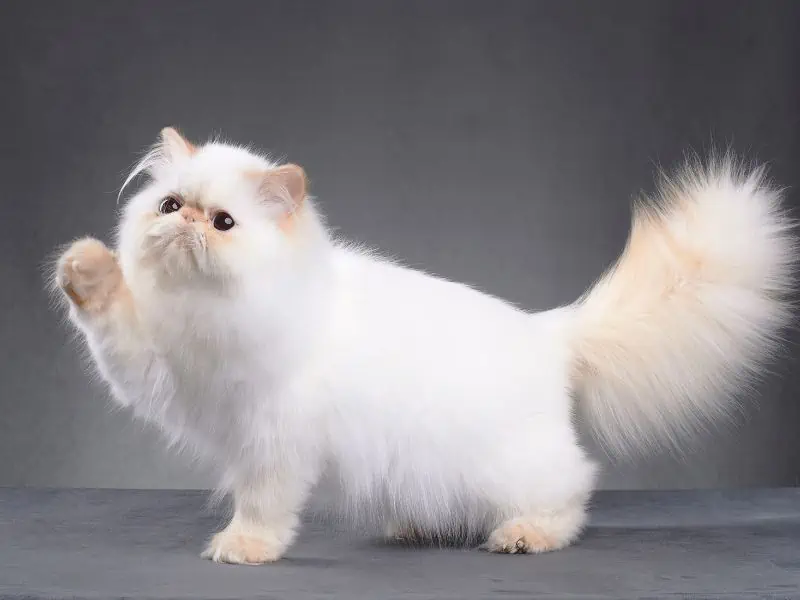
Be advised, their beautiful coat is not without its maintenance. They require daily grooming to prevent matting and tangling, so prospective owners should be prepared for this commitment. Their beautiful coats tend to be a haven for fleas, so you’ll need to be extra diligent about your flea control methods, even if they are indoor only cats!
Despite the grooming needs, their quiet, gentle nature and their affinity for a calm environment make them great indoor cats. They’re relatively inactive and prefer lounging about, making them less destructive and easier to manage than more playful breeds. They are an attractive feline that tends to prefer being admired from afar. In other words, they’re normally reserved by nature and on the shy side. Persians won’t actively seek out interaction but will enjoy a bit of affection from people they’re close to.
A quieter home is perfect for this type of cat since they don’t care for loud noises. With relatively short legs compared to other cats, they’re not the sort to jump and climb much.
While Persian cats may be less inclined towards energetic play, they’re still sociable creatures that crave human interaction.If you’d love a lap cat that likes to lounge on or beside you and you don’t mind the extra grooming needed, a Persian might the perfect pairing.
Maine Coon
The Maine Coon, often considered the “gentle giant” of the feline world, is another breed to consider if you’re contemplating adopting a cat. Bearing a striking resemblance to a wild lynx, Maine Coons are characterized by their large size, tufted ears, and long, bushy tails. They are covered in a shaggy coat, which not only adds to their majestic appearance but also serves as a practical adaptation to harsh winter climates.

One exceptional trait of Maine Coons is their affable, outgoing personality. They’re known to be highly sociable and can get along well with children and other pets. They’re not typically ‘lap cats’, but they are very affectionate and enjoy spending time with their human family members.
Differing from the Persian cat, Maine Coons are more active and playful. Their playful nature is often paired with a sense of curiosity and intelligence, making them quick to pick up tricks or solve puzzles. They also love to engage in games that involve catching or retrieving, and this is a great way to encourage physical activity and mental stimulation.
When it comes to grooming, Maine Coons, despite their long fur, are significantly easier to manage compared to Persians. A weekly brush is usually sufficient to keep their coat clean and free of mats.
In essence, if you’re searching for an active, affectionate, and hearty breed that can bring both joy and companionship to your home, the Maine Coon could be an excellent choice for you.
Ragdoll
Ragdolls are another breed that cat enthusiasts find irresistible. Ragdolls are known for their quiet and sweet nature. Among the more affectionate felines, they display unwavering devotion to their owners. This breed is exceptionally fond of snuggling and exhibits a dog-like quality, always wanting to be by your side, regardless of your location or activity within the house.
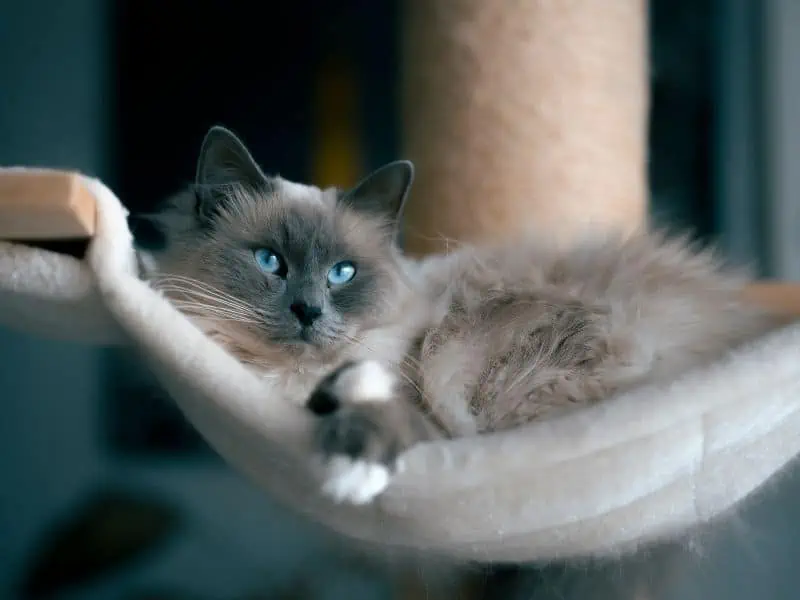
Ragdolls are famous for their docile and calm temperament. They are not only friendly but also intelligent, making them easy to train. They adapt well to their environments and get on well with children and other pets, making them an excellent choice for families.
However, prospective owners should bear in mind that Ragdolls need their coat groomed at least weekly to avoid matting and tangling. As they’re inclined to be a bit on the lazy side, it’s necessary to encourage them to play and get enough exercise. Otherwise, weight gain may be a problem as they age. Additionally, they are indoor cats and should not be allowed to roam outdoors unsupervised as their trusting nature could put them at risk.
One of the most notable characteristics of Ragdolls is their tendency to go limp when held, hence their name. This, combined with their gentle, loving nature, makes them excellent companions and lap cats. But remember, their sociable nature means they do not like being left alone for long periods. If you’re considering a Ragdoll, make sure you have plenty of time to spend with your new feline friend.
Russian Blue
Russian Blues are renowned for their striking coat of bluish-gray fur, which is both dense and plush. They possess an elegant appearance, characterized by a muscular body, slightly upturned corners to their mouth giving a slight smile, and beautiful green eyes that are both intense and captivating.
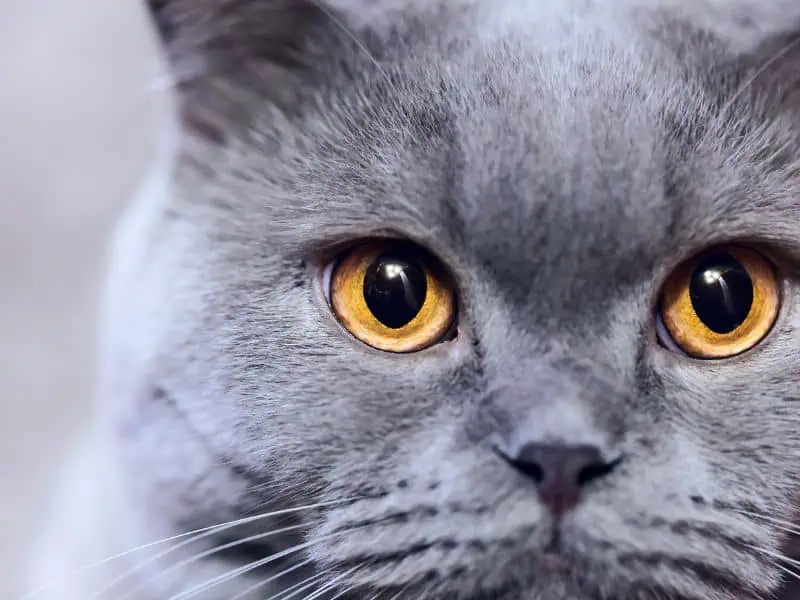
This is a very smart breed that is usually very shy and reserved, especially around new people. Russian Blues are quiet cats that are easily disturbed by loud noises and will be extra cautious around objects brought into the home. At the same time, they love to engage in playtime with their pet parent or anyone else they’ve taken a shine to. If you’d like a cat greeter at the door when you arrive home, a Russian Blue will oblige. They are quite intelligent and curious, making interactive toys a great option for mental stimulation.
Despite their plush coat, Russian Blues are low-shedding and require minimal grooming, which is a significant plus for potential owners who do not have the time for frequent grooming sessions. They are also known for their exceptional cleanliness and are often easy to litter train.
One downside to consider, however, is that Russian Blues can be somewhat reserved and may require some time to adjust to new environments or people. They also tend to form a stronger bond with one person in the household and can become anxious when separated from their favorite human. This breed may not be the right choice if you have a busy lifestyle and don’t have much time to devote to your pet. Additionally, due to their reserved nature, they may not be the best fit for households with young children or other pets.
As with the Ragdoll, Russian Blues are indoor cats and should not be allowed to roam outside unsupervised. They also benefit from regular play sessions, so an owner willing to engage in daily play is ideal to keep this clever cat happy and stimulated.
Bengal
Bengals are an exquisite breed, boasting a coat that mirrors the wild beauty of a jungle cat. Their markings, either spots or marbled, are a standout feature and come in a variety of colors, including a shimmering gold, that gives their coat an almost iridescent quality.
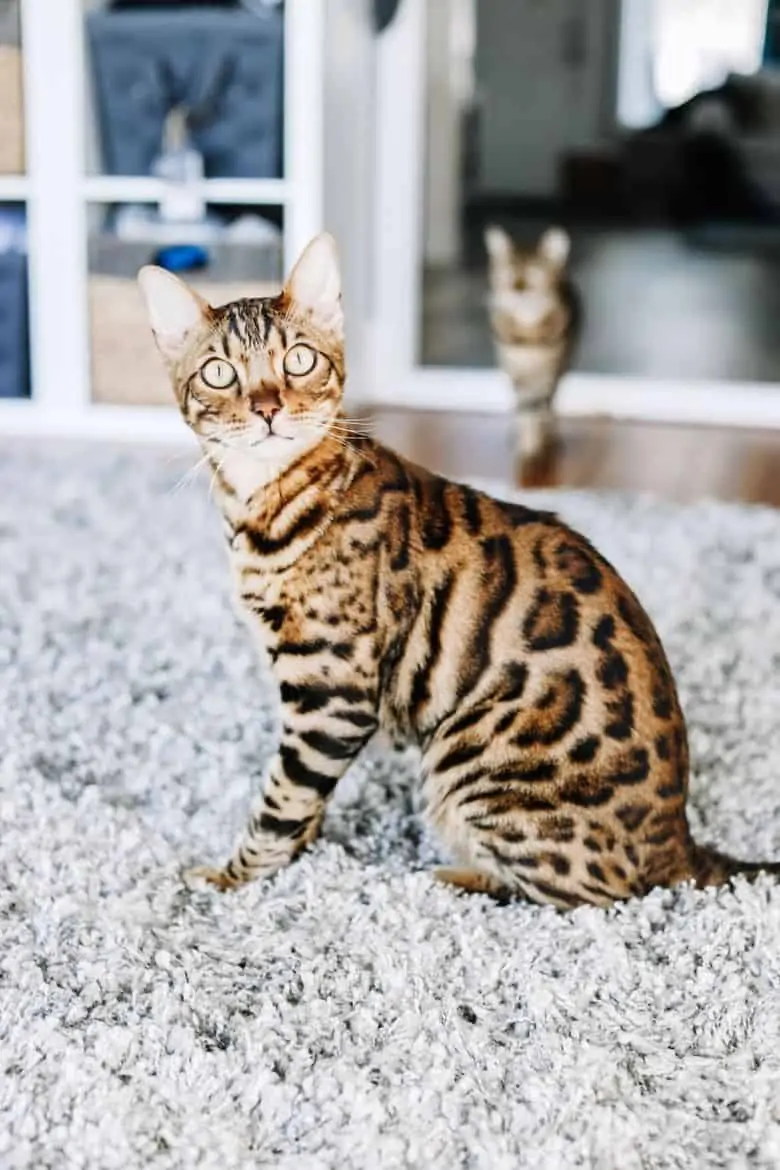
Bengals are known for their playful and active disposition which can be both entertaining and demanding. They have a high energy level, loving to climb, explore, and play, so they require plenty of stimulation to keep them entertained. A bored Bengal might resort to mischievous tactics, so be sure to invest in interactive toys, climbing trees, or even consider adopting a fellow playmate if you’re often out of the house.
Despite their adventurous tendencies, Bengals are also quite affectionate. They form strong bonds with their human companions and they can be quite chatty, often communicating with a series of chirps and meows. They also have a natural affinity for water, which is a rarity among felines, so don’t be surprised if they join you for a bath!
When it comes to grooming, Bengals are relatively low-maintenance. Their short, dense coat is easy to care for and doesn’t shed excessively. However, they do appreciate a regular brushing to distribute the natural oils on their coat.
Adopting a Bengal can be a delightful and rewarding experience if you’re ready for an active, affectionate, and stunningly beautiful cat. They’re best suited to households that can provide them with lots of play and stimulation, and are ready for a chatty and devoted companion.
Savannah Cat
Meet the Savannah cat – a breed unlike any other. This breed is a hybrid of a domestic cat and a serval, a medium-sized African wild cat, resulting in a unique and strikingly beautiful cat. With their large, rounded ears, bold spots, and long, graceful body, you might mistake a Savannah for a small cheetah!
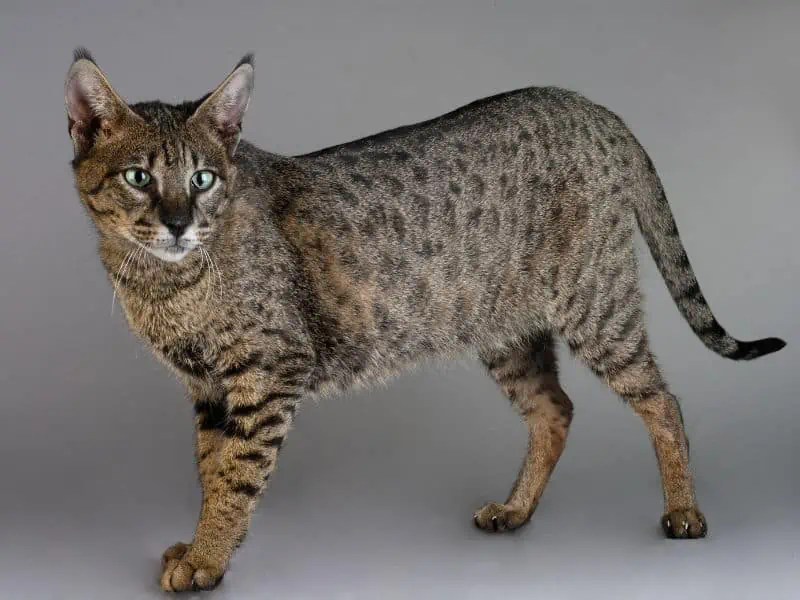
Savannah cats are known for their incredible energy levels and curiosity. They love to play and explore and will leap onto high shelves and even play fetch, much like a dog. Their curiosity can lead them into all sorts of mischief, so be prepared to offer plenty of interactive toys and puzzles to keep their minds stimulated.
If you’re looking for a cat who loves water, the Savannah is the breed for you. Much like the Bengal, Savannah cats have been known to join their owners in the shower or even swim in shallow water. They also share the Bengal’s talkative nature, often using unique chirps and squeaks to express their thoughts.
While Savannahs are not as low maintenance as Bengals in terms of grooming, their short, coarse coat does not shed much, and they require only occasional brushing. Their dietary needs are also a bit more specific – a high-protein diet is recommended to keep them healthy and energetic.
Choosing a Savannah cat for adoption means signing up for an adventurous journey. They are best suited for someone who can offer ample space to roam and explore and is ready to engage with their high-energy antics. Just like Bengals, Savannahs form strong bonds with their humans, making them a loyal and interactive companion.
Siamese
The Siamese breed is one of the oldest and most recognizable cat breeds. They are known for their striking blue almond-shaped eyes, svelte build, short and glossy coat, and distinctive color points on their ears, face, paws, and tail. Siamese cats have a strikingly elegant, angular appearance.
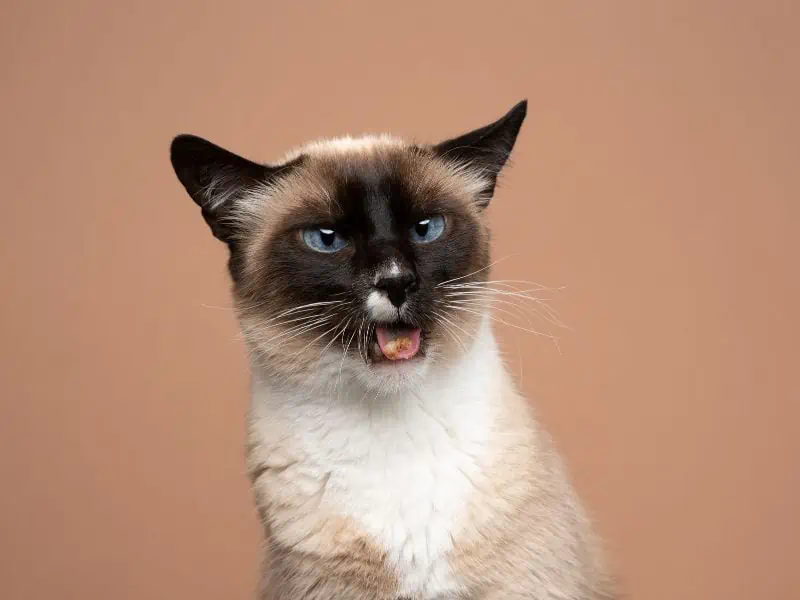
Siamese cats are very social and demand attention and affection. They enjoy the company of their human companions, forming strong, loving bonds. They are often described as “dog-like” in their tendency to follow their owners around, and they love interactive games and problem-solving toys which can keep them mentally stimulated.
One potential challenge of owning a Siamese cat is their vocal nature. They are known for their loud, low-pitched voice, and aren’t shy about using it to communicate their needs or feelings. If you’re sensitive to noise, this could be a factor to consider.
When it comes to grooming, Siamese cats are quite low maintenance, similar to Bengals. Their short coat doesn’t shed much and requires minimal grooming. However, regular brushing is still recommended to keep their coat shiny and healthy.
In terms of health, Siamese cats are generally healthy but they can be prone to certain genetic issues like heart defects and respiratory problems. Regular vet check-ups and a healthy diet can mitigate some of these risks.
These felines have a strong personality and require a considerable amount of social interaction. So, if you’re ready for a smart, active, and loving feline friend who needs your undivided attention, consider a Siamese.
So which cat breed are you leaning towards and why? I have two Bengal cats, but would love to add a Savannah to the family!